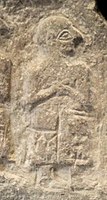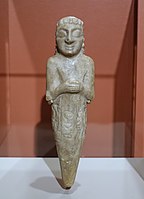Ur-Nanshe
| Ur-Nanshe 𒌨𒀭𒀏 | |
|---|---|
| King of Lugal-sha-engur | |
| Successor | Akurgal |
| Spouse | Abda?[4] Menbara-abzu[5] |
| Issue | Akurgal, Lugal-ezem, Anekura, Mukur...ta, Anunpa, Menusu, Adatur[6] |
| Dynasty | 1st Dynasty of Lagash |
| Father | Gunidu |
Ur-Nanshe (
He ascended after Lugalshaengur (lugal-ša-engur), who was the ensi, or high priest of Lagash, and is only known from the macehead inscription of Mesilim.[11]
Temples
According to
Inscriptions
Ur-Nanshe has left behind many inscriptions and plates that depict him, his family, and court.[8]
The Perforated Relief
The
𒌨𒀭𒀏 / 𒈗 / 𒉢𒁓𒆷 / 𒌉𒄖𒉌𒁺 / 𒌉𒄥𒊬 / 𒂍𒀭𒊩𒌆𒄈𒋢 𒈬𒆕 / 𒍪𒀊𒌉𒁕 𒈬𒆕 / 𒂍𒀭𒀏 𒈬𒆕
Ur-Nanshe / lugal / Lagash / dumu Gunidu / dumu Gurmu/ e2 Ningirsu mu-du3 / abzu-banda3da mu-du3 / e2 Dnanshe mu-du3
“Ur-Nanshe, king of Lagash, son of Gunidu, son of Gurmu, built the temple of Ningirsu, built Apsubanda, built the temple of Nanshe.”
The carved illustration is in two registers, top and bottom, both depicting Ur-Nanshe in different roles as king. In the top register he is dressed in a
A part of the inscriptions, in front of the seated king, reads: “Boats from the (distant) land of Dilmun carried the wood (for him)”.[7] This is the oldest known written record of Dilmun and importation of goods into Mesopotamia.[8]
-
The relief at time of discovery
-
Ur-Nanshe on the relief. He is also depicted wearing a basket for the construction of a temple.
-
Ur-Nanshe's son Akurgal (𒀀𒆳𒃲) on the relief.
-
Perforated relief of Ur-Nanshe at the Ancient Orient Museum, Istanbul, Turkey. Very similar to the Louvre's plaque. From Girsu, Iraq[18]
Door socket
An inscribed door socket from Ur-Nanshe is also known, now in the
"Ur-Nanshe, the king of Lagash, the son of Gunidu, the son of Gurmu, built the house of
-
The door socket of Ur-Nanshe at time of discovery.
The Plaque of Ur Nanshe
The Plaque of Ur Nanshe is a limestone plaque currently located at the Louvre Museum that honors Ur Nanshe. The figures displayed are the king and his court standing rigid and wide eyed, paying homage to the god Nanshe. They are dressed in kaunakes with their hands clasped together over their chest. Hierarchical scale of the king and the use of cuneiform on the figures to identify them[26] are employed as in the Perforated Relief.
𒌨𒀭𒀏 / 𒈗 / 𒉢𒁓𒆷 / 𒌉𒄖𒉌𒁺 / 𒂍𒀭𒊩𒌆𒄈𒋢 / 𒈬𒆕
Ur-Nanshe / lugal / Lagash / dumu Gunidu / E-Ningirsu / mudu
"Ur-Nanshe, king of Lagash, son of Gunidu, built the temple of
-
Plaque of Ur-Nanshe at time of discovery
-
Ur-Nanshe himself
-
Akurgal (𒀀𒆳𒃲) as a child in the limestone votive relief of Ur-Nanshe
Additional inscriptions
There are many other inscriptions found by or mentioning Ur-Nanshe. Some of them include a listing of rulers of Lagash and a Hymn to Nashe.[8]
Excerpt from Ruler of Lagash:
“Ur-Nanše, the son of ......, who built the E-Sirara, her temple of happiness and Niĝin, her beloved city, acted for 1080 years. Ane-tum, the son of Ur-Nanše”[29]
Excerpt from A Hymn to Nashe:
“There is perfection in the presence of the lady. Lagaš thrives in abundance in the presence of Nanše. She chose the šennu in her holy heart and seated Ur-Nanše, the beloved lord of Lagaš, on the throne. She gave the lofty scepter to the shepherd.”[30]
-
GoddessShul-utul, foundation peg, with inscription "Ur-Nanshe, King of Lagash, son of Gunidu, built the shrine Girsu", probably Girsu, Tell Telloh, Iraq, mid 3rd millennium BCE. Harvard Semitic Museum, Cambridge, MA
-
"
-
Votive relief of Ur-Nanshe, king of Lagash, representing the bird-god Anzû (or Im-dugud) as a lion-headed eagle. Alabaster, Early Dynastic III (2550–2500 BC). Found in Telloh, ancient city of Girsu.
-
Stele of Ur-Nanshe with goddess Nisaba, ruler of Lagash, from Lagash, Iraq, 26th century BCE. Iraq Museum
See also
References
- ^ Louvre Pouysségur, Patrick , ed. "Perforated Relief of King Ur-Nanshe." Louvre Museum. Louvre Museum. Web. 13 Mar 2013.
- ^ Transliteration: "CDLI-Found Texts". cdli.ucla.edu.
- ^ Similar text: "CDLI-Found Texts". cdli.ucla.edu.
- ^ "CDLI-Found Texts". cdli.ucla.edu.
- ^ "CDLI-Found Texts". cdli.ucla.edu.
- ^ "CDLI-Found Texts". cdli.ucla.edu.
- ^ a b c d e f g Louvre Pouysségur, Patrick , ed. "Perforated Relief of King Ur-Nanshe." Louvre Museum. Louvre Museum. Web. 13 Mar 2013.
- ^ a b c d e f CDLI Wiki University of Oxford, 14 Jan 2010. Web. 13 Mar 2013.
- ^ ISBN 9780631225522.
- ^ a b c Hansen, Donald "Royal Building Activity at Sumerian Lagash in the Early Dynastic Period." Biblical Archaeologist. 55.4 (1992): 206-11. Print.
- ^ "CDLI-Found Texts". cdli.ucla.edu.
- ^ ISBN 978-0-429-72638-5.
- ISBN 978-1-60606-649-2.
- ^ "CDLI-Found Texts". cdli.ucla.edu.
- ^ "CDLI-Found Texts". cdli.ucla.edu.
- ISBN 978-0190059040.
- ^ "CDLI-Found Texts". cdli.ucla.edu.
- ^ "RIME 1.09.01.05, ex. 01". Cuneiform Digital Library Initiative. Retrieved 27 January 2021.
- ISBN 978-0-226-45232-6.
- ISBN 978-0-226-45232-6.
- ^ Full transcription: "CDLI-Found Texts". cdli.ucla.edu.
- ^ Full transcription: "CDLI-Found Texts". cdli.ucla.edu.
- ISBN 978-0-226-45232-6.
- ISBN 978-1-60606-649-2.
- ISBN 978-1-58839-043-1.
- ^ Cole, Karl. "Plaque of Ur Nanshe." SchoolArts. 100.1 (2000): 33. Print.
- ISBN 978-1-60606-649-2.
- ISBN 978-1-58839-043-1.
- ^ E, J. translation : t.2.1.2." rulers of Lagaš (2003): n.pag. Electronic Text Corpus of Sumerian Literature. Web. 13 Mar 2013.
- ^ C, G. Translation: t.4.14.1." hymn to Nanše (Nanše A) (2003): n.pag. Electronic Text Corpus of Sumerian Literature. Web. 13 Mar 2013.
- ISBN 978-0-226-45232-6.
- JSTOR 23284262.
- ^ Full transliteration: "CDLI-Found Texts". cdli.ucla.edu.
- ^ Kramer, Noah (1964). "The Indus civilization and Dilmun" (PDF). Expeditions WWW.penn.museum: 49.
- ISBN 978-0-226-45232-6.
- JSTOR 23284262.
- ^ Full transliteration: "CDLI-Found Texts". cdli.ucla.edu.
- ^ "Louvre Museum Official Website". cartelen.louvre.fr.
- ^ Full transcription: "CDLI-Archival View". cdli.ucla.edu.
- ISBN 978-2-503-53494-7.
- ^ Découvertes en Chaldée... / publiées par L. Heuzey . 1ère-4ème livraisons / Ernest de Sarzec - Choquin de Sarzec, Ernest (1832-1901). pp. Plate XL.
- ^ "plaque / figurine". British Museum.
- ^ "CDLI-Archival View". cdli.ucla.edu.




![Inscription in front of Ur-Nanshe: "The ships of Dilmun, from the foreign lands, brought him wood as a tribute" (𒈣𒆳𒋫𒄘𒄑𒈬-𒅅, ma2 dilmun kur-ta gu2 giš mu-gal2).[17][8][7]](http://upload.wikimedia.org/wikipedia/commons/thumb/3/37/Ur-Nanshe_perforated_relief_The_ships_of_Dilmun%2C_from_the_foreign_lands%2C_brought_him_wood_as_a_tribute.jpg/200px-Ur-Nanshe_perforated_relief_The_ships_of_Dilmun%2C_from_the_foreign_lands%2C_brought_him_wood_as_a_tribute.jpg)

![Perforated relief of Ur-Nanshe at the Ancient Orient Museum, Istanbul, Turkey. Very similar to the Louvre's plaque. From Girsu, Iraq[18]](http://upload.wikimedia.org/wikipedia/commons/thumb/c/cd/Detail%2C_wall_or_door_votive_plaque._The_largest_figure_on_left_%28with_a_basket_on_his_head_is_Ur-Nanshe%2C_ruler_of_Lagash%29._Cuneiform_text._Early_Dynastic_period%2C_2550-2500_BCE._From_Girsu%2C_Iraq._Ancient_Orient_Museum%2C_Istanbul%2C_Turkey.jpg/200px-thumbnail.jpg)

!["The ships of Dilmun, from the foreign lands, brought him (Ur-Nanshe) wood as a tribute (?)" (𒈣𒆳𒋫𒄘𒄑𒈬-𒅅, ma2 dilmun kur-ta gu2 giš mu-gal2). Door socket of Ur-Nanshe.[22][23]](http://upload.wikimedia.org/wikipedia/commons/thumb/0/0c/Ships_from_Dilmun_brought_wood_tribute_from_foreign_lands.jpg/200px-Ships_from_Dilmun_brought_wood_tribute_from_foreign_lands.jpg)



![Tablet of Ur-Nanshe (Urn 24): "Ur-Nanshe, King of Lagash, son of Gunidu, the son of Gurmu, built the house of Nanshe, fashioned (the statue of) Nanshe (...) Boats from the land of Dilmun carried the wood".[31][32][33]](http://upload.wikimedia.org/wikipedia/commons/thumb/6/68/Tablet_of_Ur-Nanshe.jpg/200px-Tablet_of_Ur-Nanshe.jpg)
!["The ships of Dilmun, from the foreign lands, brought him (Ur-Nanshe) wood as a tribute (?)" (𒈣𒆳𒋫𒄘𒄑𒈬-𒅅, ma2 dilmun kur-ta gu2 giš mu-gal2). Tablet of Ur-Nanshe (Urn 24).[34][35][36][37]](http://upload.wikimedia.org/wikipedia/commons/thumb/5/5f/Boats_from_the_land_of_Dilmun_carried_the_wood.jpg/200px-Boats_from_the_land_of_Dilmun_carried_the_wood.jpg)
![Inscription in the name of Ur-Nanshe, an incantation to the reed and to Enki, before the foundation of the Girsu sanctuary for god Ningirsu.[38][39]](http://upload.wikimedia.org/wikipedia/commons/thumb/1/1e/Fragmentary_votive_inscription-AO_3866-IMG_9163-gradient.jpg/200px-Fragmentary_votive_inscription-AO_3866-IMG_9163-gradient.jpg)

!["Akurgal king of Lagash, son of Ur-Nanshe" (𒀀𒆳𒃲 𒈗 𒉢𒁓𒆷𒆠 𒌉 𒌨𒀭𒀏) on the Stele of the Vultures.[40][41]](http://upload.wikimedia.org/wikipedia/commons/thumb/d/d1/Akurgal_king_of_Lagash_son_of_Ur-Nanshe_on_the_Stele_of_the_Vultures.jpg/162px-Akurgal_king_of_Lagash_son_of_Ur-Nanshe_on_the_Stele_of_the_Vultures.jpg)

![Temple foundation figurine in the name of Ur-Nanshe. Inscription "Ur-Nanshe, King of Lagash, has built the shrine of Girsu". British Museum, BM 96565.[42][43]](http://upload.wikimedia.org/wikipedia/commons/thumb/2/2a/Temple_foundation_figurine_of_Ur-Nanshe.jpg/126px-Temple_foundation_figurine_of_Ur-Nanshe.jpg)
